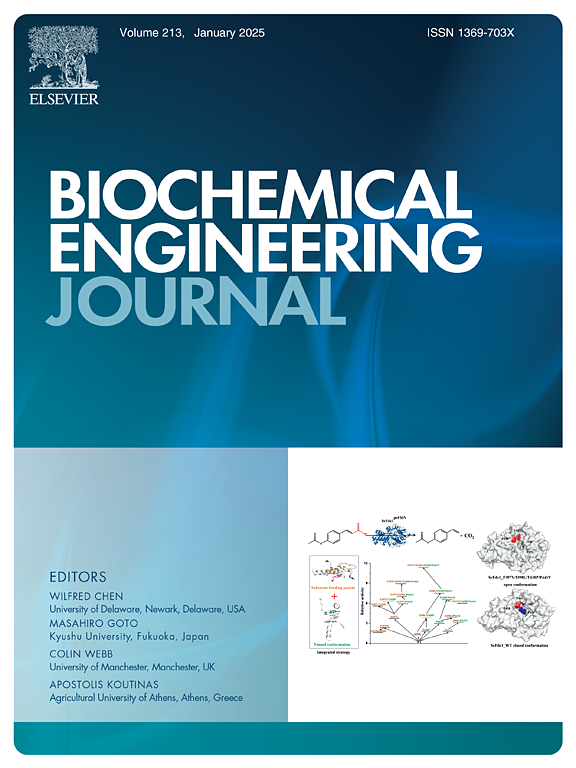新型吸附剂在乙醇脱除甲醇中的应用:柠檬酸改性4A沸石和Cu@ZIF-7
IF 3.7
3区 生物学
Q2 BIOTECHNOLOGY & APPLIED MICROBIOLOGY
引用次数: 0
摘要
乙醇作为一种重要的溶剂和基础化工原料,广泛应用于制药、食品、精细化工等行业,包括吸收、洗涤、提取等工艺。然而,无论是通过生物发酵还是化学合成,甲醇和水都是乙醇工业生产中不可避免的副产品。特别是甲醇,它对健康和环境都有害,通常以低浓度存在于乙醇产品中,对其有效去除构成重大挑战。我们设计了柠檬酸修饰的4A沸石和双金属有机骨架Cu@ZIF-7。在最佳改性条件下,改性后的4A沸石对甲醇和水的选择性分别比初始4A沸石提高了39.15 %和37.21 %。合格品收率提高44.71% %。Cu@ZIF-7对甲醇的吸附量为1.125 mg·g−1,是初始4A沸石的3.42倍。密度泛函理论(DFT)计算证实,引入的Cu位点与这种增强的甲醇吸附能力有关。实验证据表明,这些吸附剂在纯化乙醇,特别是在去除微量甲醇方面表现异常。作为一种新型的环境友好的分离方法,它在获得高纯度乙醇方面具有很大的潜力。本文章由计算机程序翻译,如有差异,请以英文原文为准。
Application of novel adsorbents in methanol removal from ethanol: Citric acid-modified 4A zeolites and Cu@ZIF-7
Ethanol, as an important solvent and basic chemical feedstock, has widespread applications in the pharmaceutical, food, and fine chemical industries, including processes such as absorption, washing, and extraction. However, methanol and water are inevitable by-products in the industrial production of ethanol, whether through biological fermentation or chemical synthesis. Particularly methanol, which is harmful to both health and the environment, is typically present in ethanol products at low concentrations, posing a significant challenge for its effective removal. We designed citric acid-modified 4A zeolites and a bimetallic organic framework Cu@ZIF-7. Under optimal modification conditions, the modified 4A zeolite showed a 39.15 % and 37.21 % increase in selectivity for methanol and water, respectively, compared to the initial 4A zeolite. The yield of qualified products increased by 44.71 %. Furthermore, Cu@ZIF-7 exhibited a methanol adsorption capacity of 1.125 mg·g−1, which is 3.42 times that of the initial 4A zeolites. Density Functional Theory (DFT) calculations confirmed that the introduced Cu sites are associated with this enhanced methanol adsorption capacity. Experimental evidence suggests that these adsorbents perform exceptionally in purifying ethanol, particularly in the removal of trace methanol. As a new, environmentally friendly separation method, it holds great potential for obtaining high-purity ethanol.
求助全文
通过发布文献求助,成功后即可免费获取论文全文。
去求助
来源期刊

Biochemical Engineering Journal
工程技术-工程:化工
CiteScore
7.10
自引率
5.10%
发文量
380
审稿时长
34 days
期刊介绍:
The Biochemical Engineering Journal aims to promote progress in the crucial chemical engineering aspects of the development of biological processes associated with everything from raw materials preparation to product recovery relevant to industries as diverse as medical/healthcare, industrial biotechnology, and environmental biotechnology.
The Journal welcomes full length original research papers, short communications, and review papers* in the following research fields:
Biocatalysis (enzyme or microbial) and biotransformations, including immobilized biocatalyst preparation and kinetics
Biosensors and Biodevices including biofabrication and novel fuel cell development
Bioseparations including scale-up and protein refolding/renaturation
Environmental Bioengineering including bioconversion, bioremediation, and microbial fuel cells
Bioreactor Systems including characterization, optimization and scale-up
Bioresources and Biorefinery Engineering including biomass conversion, biofuels, bioenergy, and optimization
Industrial Biotechnology including specialty chemicals, platform chemicals and neutraceuticals
Biomaterials and Tissue Engineering including bioartificial organs, cell encapsulation, and controlled release
Cell Culture Engineering (plant, animal or insect cells) including viral vectors, monoclonal antibodies, recombinant proteins, vaccines, and secondary metabolites
Cell Therapies and Stem Cells including pluripotent, mesenchymal and hematopoietic stem cells; immunotherapies; tissue-specific differentiation; and cryopreservation
Metabolic Engineering, Systems and Synthetic Biology including OMICS, bioinformatics, in silico biology, and metabolic flux analysis
Protein Engineering including enzyme engineering and directed evolution.
 求助内容:
求助内容: 应助结果提醒方式:
应助结果提醒方式:


